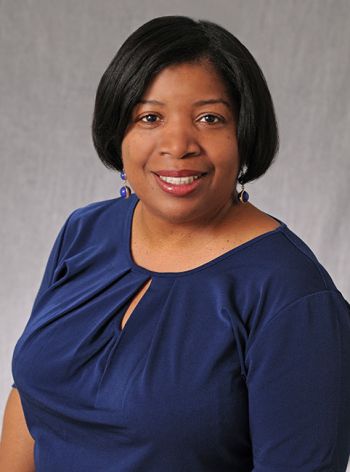
Erika Bramlette, MBA, PA-C, assistant professor of physician assistant studies and co-director of clinical education in the Department of Physician Assistant Studies at the George Washington University (GW) School of Medicine and Health Sciences (SMHS), recently attended the inaugural meeting of the health professionals chapter of the National Organization of Diversity Officers in Higher Education (NADOHE).
Bramlette, who also serves as clerkship director for women’s health, emergency medicine, and elective rotations at SMHS, was one of two physician assistant (PA) educators present at the meeting of 60 members of the health professions chapter who gathered to discuss national standards and issues related to diversity in the health professions. With an extensive background of more than 20 years practicing as a PA in underserved areas, Bramlette is dedicated to expanding diversity in the PA profession.
Here she discusses the importance of the NADOHE meeting and her efforts toward increasing diversity in the health professions.
Q: How did you get started with NADOHE and what is the organization’s mission?
A: Yolanda Haywood, MD, RESD ’87, BA ’81, senior associate dean for diversity and inclusion and associate dean for student affairs, introduced me to NADOHE. The organization’s mission is to help provide best practices for diversity officers at academic institutions. NADOHE supports and disseminates research focusing on diversity and inclusion as well as professional development. They also advocate for policy-driven initiatives both locally and nationally. Membership allows individuals from different institutions to share new ideas, network, and collaborate toward a common goal.
Q: How has your experience working as a PA in underserved areas assisted in your current work with increasing diversity at SMHS?
A: My clinical experiences have afforded me opportunities to work in prisons, Federally Qualified Health Centers (FQHC), and city hospitals that treat the underserved. That was my primary motivation in becoming a PA. As a member of an underrepresented minority group, I felt that patients were more comfortable sharing their pertinent medical and social information because I could understand and relate to them. Having a provider who shares a similar cultural background and shared experiences is key to addressing health equity and access. SMHS is committed to improving workforce diversity by investing in various pipelines and initiatives that will increase the numbers of underrepresented minorities in the health care field.
Q: How can SMHS and other institutions work toward expanding diversity in their health profession programs?
A: SMHS should continue to enhance and expand its current pipeline programs, while looking to develop new opportunities. Academic institutions like SMHS must engage in ongoing examination of institutional culture, working to identify and address barriers to recruiting diverse faculty, students, and staff, and creating and maintaining a learning environment that values diversity and inclusion.
When prospective students are considering entering the health care workforce, and ultimately start looking at different programs, it is important for them to see providers, students, and faculty who look like they do. A diverse faculty, and diversity in leadership positions, creates an environment where various perspectives and experiences are shared and valued. Prospective students recognize this, and can better see themselves as part of that community.
Q: Why is participating in advocacy groups outside of your positions at SMHS, such as NADOHE, important?
A: To broaden your perspective, you must expose yourself to persons and organizations leading efforts to diversify health professions. My participation in NADOHE allows me to return to my home institution and share information with fellow faculty members and leadership so we can incorporate best practices and strategies to increase diversity across the various health sciences programs at GW.
Q: Anything else you’d like to add?
A: NADOHE is just one organization working to improve diversity in the health care workforce. There are many opportunities for people to get involved in some way. Making real change will require the efforts of everyone.


